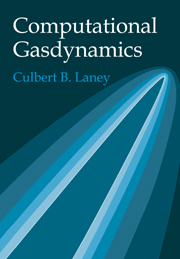Book contents
- Frontmatter
- Contents
- Preface
- Chapter 1 Introduction
- Part I Gasdynamics Review
- Part II Computational Review
- Chapter 6 Numerical Error
- Chapter 7 Orthogonal Functions
- Chapter 8 Interpolation
- Chapter 9 Piecewise-Polynomial Reconstruction
- Chapter 10 Numerical Calculus
- Part III Basic Principles of Computational Gasdynamics
- Part IV Basic Methods of Computational Gasdynamics
- Part V Advanced Methods of Computational Gasdynamics
- Index
Chapter 7 - Orthogonal Functions
Published online by Cambridge University Press: 07 December 2009
- Frontmatter
- Contents
- Preface
- Chapter 1 Introduction
- Part I Gasdynamics Review
- Part II Computational Review
- Chapter 6 Numerical Error
- Chapter 7 Orthogonal Functions
- Chapter 8 Interpolation
- Chapter 9 Piecewise-Polynomial Reconstruction
- Chapter 10 Numerical Calculus
- Part III Basic Principles of Computational Gasdynamics
- Part IV Basic Methods of Computational Gasdynamics
- Part V Advanced Methods of Computational Gasdynamics
- Index
Summary
Introduction
This chapter concerns orthogonal functions. A professor recently translated some of Elvis Presley's hit songs into Latin. The love songs were easy, but the professor had trouble with Elvis' rock hits – there are no Latin words for “blue suede shoes” or “hound dog.” Computers have a similar difficulty when it comes to functions. As seen in the last chapter, computers represent functions by finite sequences. Unfortunately, most finite sequences cannot adequately express most discontinuous functions. For example, whereas an infinite-order polynomial can represent any piecewise-smooth function, even the best finite-order polynomial approximations exhibit substantial oscillations in the presence of jump discontinuities. Of course, the best polynomial depends on how you define “best.” For example, the “best” polynomial could be the polynomial with the least error in the 1-norm, the 2-norm, the ∞-norm, or at some specified critical point. However, sometimes there are no good polynomials regardless of your criteria. This is quite often the case with discontinuous functions. Even completely smooth functions can suffer, as seen in the following example.
Example 7.1 Find the best quadratic approximation for a function with one maximum and one minimum.
Solution As seen in Figure 7.1, the error is enormous no matter which quadratic is chosen. The quadratic can model the maximum or the minimum but not both. There is simply no way to make a one-hump camel look like a two-hump camel. In this case, the choice of quadratic is largely arbitrary, and thus it is impossible to tell much about the original function by examining the chosen quadratic representation.
- Type
- Chapter
- Information
- Computational Gasdynamics , pp. 117 - 131Publisher: Cambridge University PressPrint publication year: 1998



